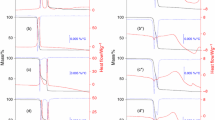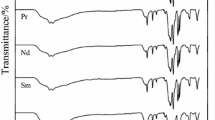Abstract
Solid state Ln–L compounds, where Ln stands for light trivalent lanthanides (L–Gd) and L is tartrate, have been synthesized. Thermogravimetry and differential thermal analysis (TG/DTA), differential scanning calorimetry (DSC), X-ray powder diffractometry, elemental analysis and complexometry were used to characterize and to study the thermal behaviour of these compounds. The results led to information about the composition, dehydration and thermal decomposition of the isolated compounds.
Similar content being viewed by others
Explore related subjects
Discover the latest articles, news and stories from top researchers in related subjects.Avoid common mistakes on your manuscript.
Introduction
Tartaric acid (dihydroxybutanedioic acid) is an organic compound which has not an ample utilization as citric and malic acids but it has a great importance in the provision industry. It is used as acidulant in some food [1].
Tartaric acid (C4H6O6) is found in the grape in form L(+) and among the organic acids of the grape, it is the strongest one [2].
A surveying the literature thermal studies involving derivatives of tartrate reported on results on the thermal decomposition and kinetics of dehydration of gadolinium (III) and praseodymium(III) tartarates [3, 4], TG and DSC studies on Sm(III) and Tb(III) tartrates [5], thermal decomposition behaviour of lanthanum(III) tris-tartrato lanthanate (III) decahydrate [6], studies on kinetics and mechanism of thermal decomposition of yttrium tartrate trihydrate crystals [7] and kinetics and mechanism of thermal decomposition of strontium tartrate crystals [8].
In the present article, solid state compounds of light trivalent lanthanides, except promethium, (La–Gd), with tartrate [(C4H4O6)−2] were prepared. The compounds were investigated by complexometry, elemental analysis, X-ray powder diffractometry, simultaneous thermogravimetry and differential thermal analysis (TG–DTA) and differential scanning calorimetry (DSC). The results allowed us to acquire information concerning these compounds in the solid state including their thermal stability and crystallinity.
Experimental
The sodium tartrate with 99% purity was obtained from Sigma-Aldrich. Aqueous solution of sodium tartrate 0.20 mol L−1 was made by direct weighing of the solid salt.
Light lanthanide(III) chlorides were prepared from the corresponding metal oxides (except for cerium) by treatment with concentrated hydrochloric acid. The resulting solutions were evaporated to near dryness, the residues were re-dissolved in distilled water and the solutions have been again evaporated to near dryness to eliminate the excess of hydrochloric acid. The residues were again dissolved in distilled water, transferred to a volumetric flask and diluted in order to obtain 0.20 mol L−1 solutions, whose pH were adjusted to 5.0 by adding diluted sodium hydroxide or hydrochloric acid solutions. Aqueous solution of cerium(III) nitrate 0.20 mol L−1 was made by direct weighing of the solid salt.
The solid state compounds were prepared by slow addition with continuous stirring the solutions of the ligand to the respective metal chloride or nitrate solutions, until total precipitation of the metal ions. The precipitates were washed with distilled water until elimination of the chloride (or nitrate) ions, filtered through and dried on Whatman no. 42 filter paper, and kept in a desiccator over anhydrous calcium chloride.
In the solid state compounds, metal ions, water and tartrate contents were determined from TG curves. The metal ions were also determined by complexometry with standard EDTA solutions [9, 10] after igniting the compounds to the respective oxides and their dissolution in hydrochloric acid.
Simultaneous TG–DTA and DSC were obtained with two thermal analysis systems, models SDT 2960 and Q 10, both from TA Instruments. The purge gas was an air flow of 150 mL mim−1. A heating rate of 20 °C min−1was adopted with sample masses about 7–8 mg. Alumina and aluminium crucibles, the latter with perforated covers were used for TG–DTA and DSC, respectively.
Carbon and hydrogen contents were determined by microanalytical procedures, with an EA 1110 CHNS-O Elemental Analyser from CE Instruments.
X-ray powder patterns were obtained by using a SIEMENS D-5000 X-ray diffractometer using CuK α radiation (λ = 1.541 Å) and setting of 40 kV and 20 mA.
Results and discussion
The analytical and thermoanalytical results of the synthesized compounds are shown in Table 1. These data permitted to establish the stoichiometry of the compounds, which are in agreement with the general formula: Ln2(C4H4O6)3·nH2O, where Ln represents trivalent light lanthanides and n = 5.0 (La–Sm) or 5.5 (Eu, Gd).
X-ray powder patterns showed that all the compounds were obtained in amorphous state. The amorphous state is undoubtedly related to the low solubility of these compounds.
Simultaneous TG–DTA curves of the compounds are shown in Fig. 1. These curves exhibit mass losses in two (Ce), four (La, Pr, Eu, Gd) and five (Nd, Sm) steps between 50 and 780 °C. The first mass loss in the 50–180 °C (La–Nd), 50–160 °C (Sm–Gd) range is ascribed to dehydration, which occurs in a single step.
After dehydration the mass losses observed above 180 °C for lanthanum to neodymium compounds (Fig. 1a–d) and above 160 °C for samarium to gadolinium compounds (Fig. 1e–g) are due to the thermal decomposition of the anhydrous compounds; these take place in consecutive and/or overlapping steps with partial losses which are characteristic for each compound.
For the cerium compound, the thermal decomposition occurs up to 350 °C with the formation of cerium(IV), CeO2 as final residue. The smaller final temperature of thermal decomposition is due to the oxidation reaction of Ce(III) to Ce(IV), together with the oxidation of the organic matter. This behaviour had already been observed for other cerium compounds [11, 12].
For the other compounds the mass loss up to 740 °C (La), 700 °C (Pr, Nd, Sm), 670 °C (Eu) and 780 °C (Gd) corresponding to endothermic or exothermic peaks attributed to the thermal decomposition being the exothermic events due to the oxidation of the organic matter.
In the final step of the thermal decomposition only the lanthanum, praseodymium and neodymium compounds exhibit an endothermic peak at 710, 550 and 655 °C, respectively, while the gadolinium compound shows an exothermic event. For the samarium and europium compounds no thermal event is observed probably because in this step exothermic and endothermic reactions must occur simultaneously; the resulting heat is insufficient to produce a thermal event. Tests with hydrochloric acid solution on samples heated up to 650 °C (La, Gd), 500 °C (Pr), 600 °C (Nd, Sm) and 550 °C (Eu) confirmed the elimination of CO2 and the presence of small quantity of carbonaceous residues showing that in this step occurs the formation of an intermediate derivate of carbonate, probably the dioxycarbonate, as already observed during the thermal decomposition of other lanthanide compounds [11, 12].
Therefore, the lost mass is due to the thermal decomposition of the intermediate and oxidation of the carbonaceous residue, with formation of the respective oxides, Pr6O11, Ln2O3 (L = La, Nd, Sm, Eu, Gd).
The mass losses, temperature ranges and the peak temperatures observed for each step of the TG–DTA curves are shown in Table 2. During the thermal decomposition of these compounds, the formation of oxalate as intermediate was not observed in disagreement with [2–5] even the formation of Pr2O3 as final residue.
The DSC curves of the compounds are shown in Fig. 2. These curves show endothermic and exothermic peaks that all are in agreement with the mass losses observed in the TG curves. The endothermic peak at 116–125 °C is assigned to the dehydration, which occurs in single step. The dehydration enthalpies found for the compounds (La to Gd) were: 145.8, 157.9, 102.9, 165.7, 159.6, 181.2, and 208.6 kJ mol−1, respectively.
Conclusions
From TG curves and from the results of elemental analysis and complexometry a general formula could be established for these compounds in the solid state.
The TG–DTA and DSC curves provided information on the dehydration, thermal stability and thermal decomposition of these compounds.
References
Evangelista J. Tecnologia de alimentos. São Paulo: Editora Atheneu; 1999. p. 49.
Rizzon LA, Miele A. Concentração de ácido tartárico nos vinhos da Serra Gaúcha. Cienc Rural, Santa Maria. 2001;31:893–5.
Want B, Ahmad F, Kotru PN. Crystal growth and characterization of gadolinium tartrate trihydrate: Gd(C4H4O6)(C4H5O6)·3H2O. Mater Sci Eng A. 2006;431:237.
Sharma RM, Kaul ML. Thermal decomposition and kinetics of dehydration of praseodymium(III) tartarate hexahydrate. J Ind Chem Soc. 1990;67:706.
Sharma RM, Kaul ML. TG and DSC studies on Sm(III) and Tb(III) tartrates. J Thermal Anal. 1989;35:2143–52.
Deb N. Thermal decomposition behaviour of lanthanum(III) tris-tartrato lanthanate(III) decahydrate. J Therm Anal Calorim. 2004;78:227–37.
Bamzai KK, Kumar S. Studies on kinetics and mechanism of thermal decomposition of yttrium tartrate trihydrate crystals. Mater Chem Phys. 2008;107:200–7.
Arora SK, Patel V, Kothari A. Kinetics and mechanism of thermal decomposition of strontium tartrate crystals. Mater Chem Phys. 2004;84:323–30.
Flaschka HA. EDTA titrations. Oxford: Pergamon Press; 1964.
Ionashiro M, Gramer CAF, Zuanon Netto J. Complexometric titration of lanthanides and yttrium. Eclet Quim. 1983;8:29.
Siqueira AB, Bannach G, Rodrigues EC, Carvalho CT, Ionashiro M. Solid-state 2-methoxybenzoates of light trivalent lanthanides: synthesis, characterization and thermal behaviour. J Therm Anal Calorim. 2008;91:897–902.
Ionashiro EY, Bannach G, Siqueira AB, Carvalho CT, Rodrigues EC, Ionashiro M. 2-Methoxybenzylidenepyruvatewith heavier trivalent lanthanides and yttrium(III). J Therm Anal Calorim. 2008;92:953–9.
Acknowledgements
The authors thank FAPESP, CAPES and CNPq Foundations (Brazil) for financial support.
Author information
Authors and Affiliations
Corresponding author
Rights and permissions
About this article
Cite this article
Ambrozini, B., Dametto, P.R., Siqueira, A.B. et al. Synthesis, characterization and thermal behavior on solid tartrates of light trivalent lanthanides. J Therm Anal Calorim 97, 761–764 (2009). https://doi.org/10.1007/s10973-009-0329-4
Published:
Issue Date:
DOI: https://doi.org/10.1007/s10973-009-0329-4






